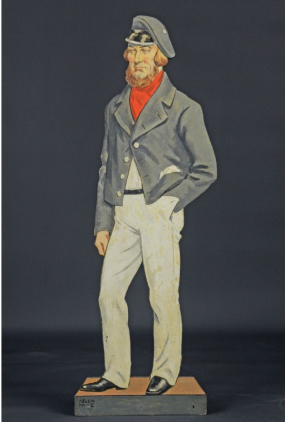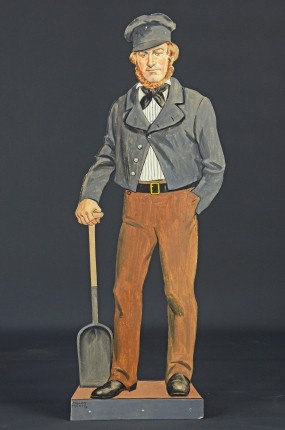09th November 2020
Railway employment in Dale Street, Dove Street and Swann Street, 1841-1881
Judith Hoyle and our Poverty Research Group have been exploring railway work in our research area, in the 19th century
 Extract from map of York showing part of the parish of St Mary Bishophill Junior, OS six inch map Yorkshire 174 surveyed 1846-51; pub. 1853. See https://maps.nls.uk/view/10234481
Extract from map of York showing part of the parish of St Mary Bishophill Junior, OS six inch map Yorkshire 174 surveyed 1846-51; pub. 1853. See https://maps.nls.uk/view/10234481
Investigating poverty reveals the range of ways that local residents made ends meet. Many found employment in a variety of settings. For men, the railway industry was a major employer.
This post looks at the significance of railway-related jobs for those living in three streets in St Mary Bishophill Junior parish, between 1841 and 1881. In 1851 only 7% of jobs in York were railway-related, with 19% in manufacturing and 15% in making and dealing in clothing and shoes. Railway work in the city increased through the century, employing 420 in 1851, and 3,170 by 1911. The numbers employed in transport and communications almost doubled - from 7% to 13% - in this period.
Models of engine driver and firemen 1852 (National Railway Museum, Science Museum Group)

 For our three streets the importance of railway-related employment increased between 1841 and 1881. In 1841 fourteen (8% of the men in our streets) were employed in the industry, including three engine drivers and two engine fitters. By 1861 there were 66 (28%), including thirteen engine fitters and twelve railway labourers. By 1881 this number had further increased to 73 (37%) including 18 engine fitters, though the number of labourers had fallen to four. There were nine railway trades and occupations in 1841 rising to twenty in 1881, including engine drivers, engineers, guards, clerks, labourers and porters.
For our three streets the importance of railway-related employment increased between 1841 and 1881. In 1841 fourteen (8% of the men in our streets) were employed in the industry, including three engine drivers and two engine fitters. By 1861 there were 66 (28%), including thirteen engine fitters and twelve railway labourers. By 1881 this number had further increased to 73 (37%) including 18 engine fitters, though the number of labourers had fallen to four. There were nine railway trades and occupations in 1841 rising to twenty in 1881, including engine drivers, engineers, guards, clerks, labourers and porters.
In the first two censuses there are a greater number of railway workers living in Dale Street and Swann Street than in Dove Street. By 1881 that is no longer the case and the numbers are more or less evenly spread.
1841 |
Dale St |
Dove St |
Swann St |
Total |
|
|
|
Assistant on railway |
|
1 |
|
1 |
|||
Engine cleaner |
|
|
1 |
1 |
|||
Engine driver |
|
|
3 |
3 |
|||
Engine fitter |
|
|
2 |
2 |
|||
Plate layer on railway |
1 |
|
|
1 |
|||
Railway clerk |
|
1 |
|
1 |
|||
Railway guard |
1 |
|
1 |
2 |
|||
Railway police |
1 |
|
|
1 |
|||
Railway porter |
2 |
|
|
1 |
|||
Men employed by railways |
5 |
2 |
7 |
14 |
|||
Total men in employment |
|
|
|
181 |
|||
% of total employed by railways |
|
|
|
8 |
|||
1861 |
Dale St |
Dove St |
Swann St |
Total |
|
|
|
At The Railway |
1 |
|
|
1 |
|||
Engine Driver |
|
3 |
1 |
4 |
|||
Engine Fitter |
7 |
3 |
3 |
13 |
|||
Engine Smith |
2 |
|
|
2 |
|||
Engine Stoker/Locomotive stoker/Fireman |
3 |
|
3 |
6 |
|||
Engineer / comb manufacturer |
1 |
|
|
1 |
|||
Fitter |
1 |
1 |
1 |
3 |
|||
Fitters Labourer |
|
|
1 |
1 |
|||
Lamp Inspector N E Railway |
1 |
|
|
1 |
|||
Platelayer |
|
|
2 |
2 |
|||
Pointsman |
|
|
1 |
1 |
|||
Railway & spring Maker |
1 |
|
|
1 |
|||
Railway Clerk |
1 |
4 |
|
5 |
|||
Railway Goods Guard |
|
|
3 |
3 |
|||
Railway Guard |
|
|
2 |
2 |
|||
Railway Labourer |
5 |
2 |
5 |
12 |
|||
Railway Porter |
3 |
|
2 |
5 |
|||
Railway Repairer |
|
|
1 |
1 |
|||
Travelling Railway Inspector |
|
1 |
|
1 |
|||
Wagon Fitter |
1 |
|
|
1 |
|||
Men employed by railways |
27 |
14 |
25 |
66 |
|||
Total men in employment |
|
|
|
233 |
|||
% of total employed by railways |
|
|
|
28 |
|||
1881 |
Dale St |
Dove St |
Swann St |
Total |
|
|
|
Carriage Fitter (Rly) |
1 |
|
|
1 |
|||
Engine Fitter |
6 |
3 |
9 |
18 |
|||
Engine Smith (NER) |
|
|
1 |
1 |
|||
Engine Spring Maker ( E & M ) |
1 |
|
|
1 |
|||
Engineer At N E R ( E & M ) |
1 |
3 |
1 |
5 |
|||
Fitter ( E & M ) |
2 |
|
|
2 |
|||
Guard N E Railway |
3 |
1 |
3 |
7 |
|||
Locomotive Engine Driver (Rly) |
|
2 |
|
2 |
|||
Locomotive Fireman (Rly) |
1 |
2 |
|
3 |
|||
Lumber At The RLW |
|
1 |
|
1 |
|||
Painter At The RLW |
|
1 |
1 |
2 |
|||
Railway Carriage Trimmer |
1 |
|
2 |
3 |
|||
Railway Clerk |
2 |
5 |
|
7 |
|||
Railway Engine Cleaner |
|
1 |
1 |
2 |
|||
Railway Labourer |
2 |
|
2 |
4 |
|||
Railway Platelayer |
|
1 |
1 |
2 |
|||
Railway Porter |
1 |
1 |
2 |
4 |
|||
Railway Signalman |
|
1 |
2 |
3 |
|||
Railway Stoker |
|
1 |
1 |
2 |
|||
Wagon Fitter (Rly) |
3 |
|
|
3 |
|||
Men employed by railways |
24 |
23 |
26 |
73 |
|||
Total men in employment |
|
|
|
198 |
|||
% of total employed by railways |
|
|
|
37 |
|||


 York apprentices model train North Eastern Railway 1870. This model steam train is 1/8 scale and reputedly made at the Railway Carriage Shops at York. It is said to have been carried in procession around the city by railwaymen to celebrate the inauguration of a nine-hour working day which came into force in 1872. (National Railway Museum Science Museum Group)
York apprentices model train North Eastern Railway 1870. This model steam train is 1/8 scale and reputedly made at the Railway Carriage Shops at York. It is said to have been carried in procession around the city by railwaymen to celebrate the inauguration of a nine-hour working day which came into force in 1872. (National Railway Museum Science Museum Group)
